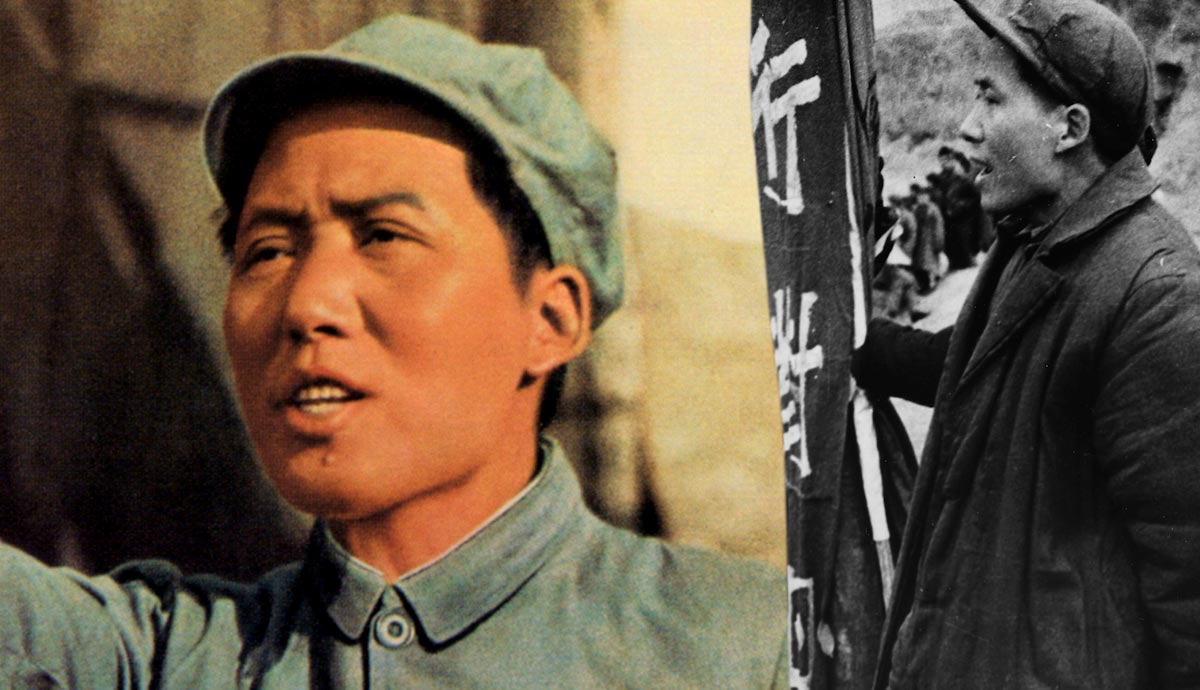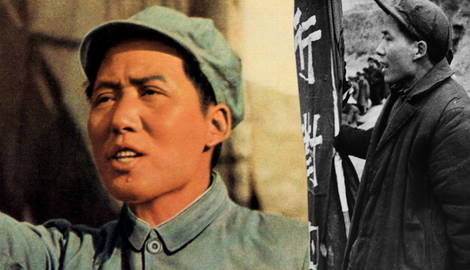
He was a Chinese revolutionary, political leader, and founding father of the People’s Republic of China. He played a central role in the Chinese Communist Party and led the country through a series of significant social and political transformations. But where did it all begin, and how did Mao Zedong climb the ranks?
Mao Zedong: Early Life

Mao Zedong (Tse-Tung) was born on December 26th, 1893, in Hunan, China, to one of the richest farmers in the village of Shaoshan. Although not materially deprived on the farm like much of China during this period, Mao and his two brothers, Zemin and Zetan, and adoptive sister Zejian were viciously beaten by their disciplinarian father, Mao Yichang. Their mother, Wen Qimei, however, tempered their father as best she could, likely due to her Buddhist beliefs. Mao adopted Buddhism from his mother but quickly discarded it in his teens. At thirteen, Mao was forcefully married to a local girl aged seventeen named Luo Yixiu in what essentially amounted to a business deal for his father. This practice of arranged marriage is one Mao would later denounce, and Yixiu would die in 1910, aged twenty-one, locally disgraced.
During these early years working on his father’s farm, Mao would feverishly devour intellectual material. He was particularly interested in writers such as Aldous Huxley, Jean-Jacques Rousseau, Charles Darwin, and Adam Smith. He also, perhaps foreshadowing his prowess in martial matters during the Civil War, fascinated himself with the military prowess and nationalist vigor of George Washington and Napoleon Bonaparte.
In 1911, Mao began schooling in Changsha, a revolutionary hotbed at the time. The city’s fervor advocated for a republican future and, therefore, an end to Emperor Puyi’s absolute monarchy. The Republican figurehead was Sun Yat-sen, who, in a school essay, Mao would suggest should become president. Mao was heavily influenced by Sun’s revolutionary newspaper, The People’s Independence. The very same year that Mao started school in Changsha saw the start of the Xinhai Revolution.

As Changsha’s governor fled north, Mao joined Sun’s rebel army. However, Sun would claim the title of “provisional president” and avoid civil war with his monarchist counterpart. The Republic of China was founded, and monarchist general Yuan Shikai became president in a compromise with Sun’s nationalist-revolutionary movement. Mao would not see combat during this period, and after six months as a soldier, he resigned from the army in 1912.
After this ordeal, Mao tried his hand at many crafts; policing, law, and economics are a few disciplines he explored during his independent study in the libraries. By this point, Mao’s academic and intellectual pursuits had frustrated his father, who saw no future in them. His father cut off his allowance, leaving him destitute in a hostel. Mao was forced to beg on the streets and sell intellectual pamphlets to be able to eat.
After enrolling at the Fourth Normal School of Changsha, widely believed to be the best in Hunan, Mao published his first article in New Youth, a revolutionary paper. In the article, he suggests readers improve their physical capacities to strengthen the revolution. Mao was also involved in the formation of the Renovation of the People Study Society in 1918. This group would discuss the ideas of Chen Duxiu, a dean at Peking University who also desired radical change in Chinese society. The group gained 70-80 members, many of whom, like Mao, would join the Communist Party. In June 1919, Mao graduated with an impressive third-place ranking in his entire year group.
Journey to the Communist Party

In 1917, Mao moved to Beijing to become the library assistant to Li Dazhao, who would go on to become a founding member of the Chinese Communist Party. Li had documented Lenin’s revolution in Russia, and his influence would lead Mao quickly toward Marxism by the winter of 1919. Mao’s wage as an assistant was paltry, and he was forced to share a cramped room with seven other students. However, he felt Beijing’s beauty was “compensation” for this discomfort. Much like Stalin’s marginalization in intellectual groups because of his Georgian background, Mao was snubbed due to his rural Hunanese accent. Mao spent much time between Beijing and Shanghai, not deigning to visit his home village of Shaoshan for many more years. His mother would die there in 1919, shortly followed by his father in early 1920.
Mao began production of the radical magazine Xiang River Review, in which he used common vernacular to target the average reader rather than appealing to intellectualism. In the magazine, he would advocate for a “Great Union of the Popular Masses” as well as support feminist ideas and the liberation of women across China–an idea influenced by his early forced marriage.
In June 1920, alongside Kuomintang (KMT) member Yi Peiji and General Tan Yankai, Mao helped overthrow the governor of the Hunan province, Zhang. He assisted in organizing the students in Changsha and was awarded his first high-paying job as headmaster in the newly organized province. With his newly attained income, he married his second wife, Yang Kaihui, in the winter of the same year.

The Chinese Communist Party was founded in 1921 as an informal network, and it held its first session in Shanghai not long after. Thirteen delegates attended this meeting, and Mao was one of them. He soon became party secretary for the province of Hunan, and he aimed to build support for the party there through a variety of tactics.
He employed numerous methods, such as founding mass literacy movements and editing textbooks to include revolutionary sentiments. However, the most notable and successful episode was during the Anyuan coal mining strikes. Mao would form schools and cooperatives. His wife was also included in the process; she would address women’s rights and help raise literacy in nearby peasant communities. His marked success in the Anyuan mining strikes led to his being invited into the Central Committee of the Communist Party.

In July 1922, the Communist Party struck an alliance with the nationalist party still led by Sun Yat-sen, the KMT. Mao was enthused by the cooperation and became the propaganda chief for the KMT. During this period, Mao finally returned to Shaoshan to discover peasants had seized some land from rich owners to form communes. He was inspired by their actions and recognized the potential of their peasant masses. By 1925, Mao was forced to flee to Guangzhou due to the suspicions surrounding his growing revolutionary fervor. He would drill the peasants as if they were soldiers and expose them to introductory left-wing texts.
KMT leader Sun Yat-sen died on March 12th, 1925. His successor was Chiang Kai-Shek, a leader who opposed the communist party in which Mao had so deeply rooted himself and even opposed left-leaning members of his own party. In 1926, his National Revolutionary Army embarked on the “Northern Expedition” against Chinese warlords, a movement Mao agreed with. However, on Chiang’s return in 1927, he and his forces turned their attention against the increasingly powerful Communists.
Mao Zedong and the Civil War

Chiang massacred thousands of communists; 15,000 of the 25,000 members were lost, including nineteen leading members in Beijing. Mao decided to stake his hope on his peasant militia, and the party would go on to found the “Workers and Peasants Army of China,” more commonly known as the Red Army. Mao was appointed commander-in-chief of the Red Army and led four regiments against the KMT in the “Autumn Harvest.” His fourth regiment would desert to the KMT and attack his own army on September 9th. By the 15th, Mao was forced to admit defeat and retreat from Changsha to Jiangxi with only one thousand survivors, where he would establish a base.
Mao was ridiculed by orthodox communists for his goal of mobilizing the peasantry, but after his defeat, he successfully created another army of two thousand in his newly controlled territory around the mountains. In 1928, Mao married an eighteen-year-old revolutionary named He Zizhen, with whom he would have six children over the coming years. Two years later, his second wife, Yung Kaihui, was beheaded by a KMT general.

During this time, Japan was becoming an increasing distraction for Chiang’s KMT, and it allowed the Red Army’s influence to grow to an area with a population of three million. This situation led to the most important event for Mao’s rise to ultimate power: “The Long March.” In October 1934, a one-hundred-thousand-strong Communist force broke through KMT lines, and by January 1935, Mao was elected Chairman of the Politburo, making him in charge of both the army and the party. His candidacy was supported by Joseph Stalin.
Mao’s march aimed north to the Shenshi Soviet. He hoped to reach an area where he could fight the Japanese. The idea was to earn the trust of the Chinese people by fighting their imperialist invaders and, in turn, incentivizing them to denounce the KMT. During the march, Mao’s force fended off KMT forces, Islamic cavalry, and Manchu tribesmen to eventually reach the target with 7,000 survivors. This achievement led to his being appointed chairman of the military commission in November 1935 and becoming the undisputed leader of the communist party.

Over the next 15 years, Mao would create a communist-led Chinese front with the KMT against the Japanese presence. By 1949, he had turned against the KMT and finally driven Chiang and the surviving members away to Taiwan. On October 1st, 1949, Mao proudly proclaimed the establishment of the People’s Republic of China and announced to his people, “The Chinese people have stood up.”










